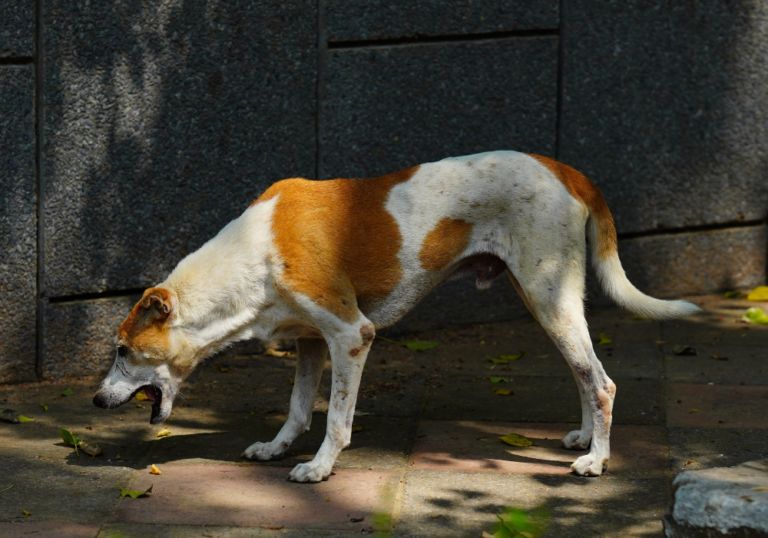Types of Dog Vomit & What it Means

Did you know there are different types of dog vomit? While it may not be the most pleasant topic, it’s crucial for pet parents to understand the significance of the color, texture, and consistency of vomit. After all, many dogs throw up occasionally over the course of their lives.
While you might expect a puddle resembling half-digested dog food, vomit can actually appear in a variety of colors and textures—each providing vital clues about your dog’s health. For instance, a dog throwing up yellow vomit likely indicates something different than a canine who has red or pink vomit.
Here’s what you need to know about the types of dog vomit and how to support your pet during these times.
Types of Dog Vomit
It’s important to remember that there isn’t a single type of vomit; the causes can vary significantly. However, some common characteristics can hint at its nature and origin.
Dog Vomit Color Guide
Color is one of the most telling features when it comes to dog vomit. Be vigilant—if your dog vomits blood (represented by red or pink colors), you should consult our doctors at Acacia Pet Clinic immediately.
Here are some common colors of dog vomit and their possible meanings:
Color: White
- Possible Consistency: Foamy
- Possible Causes: Digestive upset, acid reflux, intestinal blockages, ingestion of toxins, regurgitation*.
Color: Clear
- Possible Consistency: Liquid
- Possible Causes: Nausea, indigestion, kidney or liver failure, toxins, regurgitation*.
Color: Green
- Possible Consistency: Firm or liquid
- Possible Causes: Bile, grass, indigestion, food allergies, toxins.
Color: Brown
- Possible Consistency: Firm or liquid, coffee grounds
- Possible Causes: Blood, poop, chocolate.
Color: Red or Pink
- Possible Consistency: Firm or liquid, coffee grounds
- Possible Causes: Blood, gastrointestinal disease, internal obstruction, blockage.
Regurgitation is distinctively different from vomiting. It is a passive expulsion of food or fluid without any nausea, salivation, or retching. Recognizing the difference between vomiting and regurgitation can be essential in helping your pet.
Consistency of Dog Vomit
The consistency or texture of dog vomit can also provide important clues. Here are some types you might see:
- Foam: Typically made up of stomach and saliva fluids, white foam could indicate intestinal distress.
- Liquid: Thin, clear liquid may be water your dog drank, saliva, or stomach secretions. Indigestion is likely, but more serious causes such as toxins and heatstroke could also be possible.
- Chunky or Firm: This can include partially digested food. If your dog throws up shortly after eating, they might be regurgitating their meal. Non-food substances (like grass or household objects) can also result in a chunky or firm consistency.
Dog Throwing Up Bile
Bile is a substance produced by the liver that aids in digestion. Yellow or green vomit is often associated with bile and can indicate bilious vomiting syndrome, where bile leaks into the stomach. This condition can cause early morning vomiting, especially when the stomach is empty for an extended period.
Conditions that irritate or inflame the stomach, or alter the motility of the stomach or intestines, can also contribute to this syndrome.
How to Help Your Dog if They’re Throwing Up
Understanding the different types of dog vomit is crucial, but don’t forget to comfort your furry friend. Here are some steps you can take:
- Look for Other Symptoms: If vomiting is accompanied by diarrhea or lethargy, your dog may have a medical condition. Contact our doctors at Acacia Pet Clinic.
- Provide Love and Support: Some dogs may want to be left alone if they feel nauseous. However, if they’re open to it, affection and gentle petting can help ease their discomfort.
- Consult Our Doctors at Acacia Pet Clinic: If your dog vomits once and you have a good idea of the cause, you likely don’t need to worry. However, if vomiting continues within a 24-hour period, becomes a recurring issue, or contains blood or bright colors, reach out for professional help.
As a pet owner, understanding the color and consistency of dog vomit can empower you to provide better care for your canine companion. Moreover, you can potentially flag issues before they escalate into more serious conditions.
If you need more help or have any questions, call us at Acacia Pet Clinic, (408) 264-6354, 4486 Pearl Ave, San Jose, CA 95136,
Hours: Monday-Friday: 8:00 am – 5:00 pm or visit us online.

